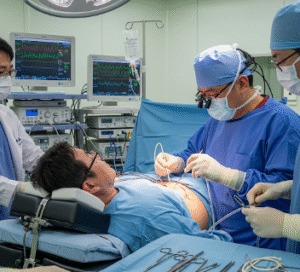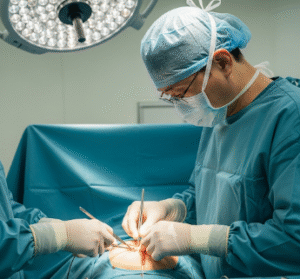Overview
Ventriculostomy is a neurosurgical procedure that involves creating an opening in the brain’s ventricles to drain cerebrospinal fluid (CSF). It is primarily used to relieve intracranial pressure caused by hydrocephalus, brain hemorrhage, tumors, or traumatic brain injury.
South Korea is renowned for advanced neurosurgical care, offering state-of-the-art operating rooms, precision-guided techniques, and highly skilled neurosurgeons. Patients benefit from accurate diagnosis, minimally invasive approaches, and comprehensive postoperative care.
Ventriculostomy is typically recommended for patients who:
- ➤ Have acute or chronic hydrocephalus
- ➤ Suffer from increased intracranial pressure due to hemorrhage, tumor, or trauma
- ➤ Require temporary CSF drainage before definitive surgery
- ➤ Seek rapid relief from neurological symptoms
What is Ventriculostomy?
Ventriculostomy, also called external ventricular drain (EVD) placement, involves inserting a catheter into the cerebral ventricles to monitor and drain excess CSF.
Key points:
- Performed under general anesthesia
- Can be emergency or elective, depending on clinical condition
- Provides both therapeutic relief and diagnostic monitoring
- May be temporary until permanent shunt placement or resolution of underlying condition
- Korean hospitals utilize stereotactic guidance and advanced imaging to ensure precise catheter placement and reduce complications
What are the Benefits?
✔ Immediate relief of elevated intracranial pressure
✔ Prevents neurological damage caused by fluid accumulation
✔ Allows monitoring of intracranial pressure in real time
✔ Temporary or preparatory measure for other neurosurgical interventions
✔ Minimally invasive when performed using advanced techniques
Additional benefits include:
- ➤ Rapid intervention in life-threatening conditions
- ➤ Can help guide subsequent surgical or medical treatment
- ➤ High precision placement with reduced risk of injury to brain structures
- ➤ Korean hospitals provide expert monitoring, sterile environment, and specialized ICU care
Procedure Details:
1) How should I prepare for Ventriculostomy?
- ● Medical evaluation: Imaging studies like CT or MRI to locate ventricles and plan catheter trajectory
- ● Medical history: Discuss medications, allergies, and prior brain surgery
- ● ● Medication adjustments: Blood thinners may need temporary cessation
- ● Consent and counseling: Procedure explained including benefits and potential risks
- ● Fasting: Required if general anesthesia will be used
- ● Korean hospitals: Provide preoperative planning, digital imaging guidance, and ICU readiness
2) What happens during the procedure Ventriculostomy?
- ➤ Anesthesia: General anesthesia for comfort and safety
- ➤ Surgical steps:
- Patient’s head positioned and sterilized
- Small burr hole drilled in the skull to access the lateral ventricle
- Catheter carefully inserted into ventricle using stereotactic or freehand guidance
- Catheter connected to an external drainage system for CSF monitoring or removal
- ➤ Duration: Typically 30–60 minutes
- ➤ Korean advantage: Surgeons employ advanced imaging, neuronavigation, and sterile techniques to reduce complications and improve outcomes
3) What happens after Ventriculostomy?
- ● Immediate care: Patient monitored in ICU; CSF drainage and intracranial pressure closely tracked
- ● Activity: Strict bed rest initially; limited movement to prevent catheter dislodgment
- ● Wound care: Catheter entry site cleaned and secured; infection prevention is critical
- ● Follow-up: Regular neurological assessments and imaging studies to monitor recovery and CSF drainage efficiency
- ● Korean hospitals: Offer structured postoperative monitoring, infection control protocols, and multidisciplinary neurosurgical support
Risks / Benefits
✔ Benefits:
- ✦ Immediate relief from high intracranial pressure
- ✦ Allows continuous monitoring and diagnostic assessment
- ✦ Minimally invasive when performed by skilled neurosurgeons
- ✦ Provides bridge therapy before definitive neurosurgical interventions
⚠ Possible Risks (rare but serious):
- ➔ Infection, including meningitis or ventriculitis
- ➔ Bleeding or hematoma at catheter site
- ➔ Catheter blockage or malfunction
- ➔ Neurological deficits if surrounding brain tissue is injured
- ➔ CSF leakage
- ➔ Need for repeat procedure if catheter malfunctions
Recovery and Outlook
- ➤ Immediate recovery: Monitored in ICU; patient may remain sedated initially
- ➤ Activity restrictions: Minimal movement to avoid dislodging catheter
- ➤ Duration of drainage: Varies; temporary catheter until intracranial pressure stabilizes or permanent shunt placed
- ➤ Long-term outlook: Successful ventriculostomy can prevent brain damage, improve neurological outcomes, and allow safe transition to definitive therapy
- ➤ Korean advantage: Expert neurosurgical teams, advanced monitoring, and ICU care optimize safety, recovery, and prognosis
When To Call the Doctor
Contact the neurosurgical team if there is:
- ⚠ Fever or signs of infection
- ⚠ Increased headache or neurological deterioration
- ⚠ CSF leakage from catheter site
- ⚠ Catheter dislodgment or blockage
- ⚠ Unusual bleeding or swelling
Best Korea Option / Process
South Korea is a world leader in neurosurgical care, including ventriculostomy, due to:
- 🌟 Highly skilled neurosurgeons with experience in critical care
- 🌟 State-of-the-art operating rooms with stereotactic and neuronavigation support
- 🌟 Advanced ICU monitoring for postoperative care
- 🌟 Comprehensive infection control and patient safety protocols
- 🌟 Multilingual support for international patients seeking critical neurosurgical procedures
Top Korean Hospitals for Ventriculostomy:
- ✅ Seoul National University Hospital (Neurosurgery Dept.)
- ✅ Asan Medical Center
- ✅ Samsung Medical Center
- ✅ Severance Hospital (Yonsei University)
- ✅ Bundang CHA Hospital
✅ Quick Highlights Recap
- ➤ Minimally invasive procedure to drain cerebrospinal fluid from brain ventricles
- ➤ Relieves elevated intracranial pressure and prevents neurological damage
- ➤ Temporary or preparatory measure before definitive neurosurgical therapy
- ➤ Rare but serious risks, mostly preventable with expert care
- ➤ Korean hospitals provide advanced imaging, skilled neurosurgeons, ICU monitoring, and structured postoperative care













